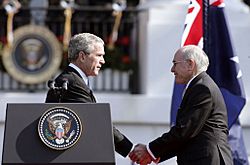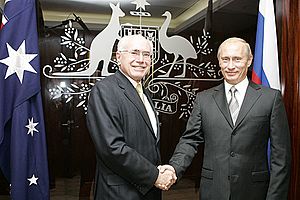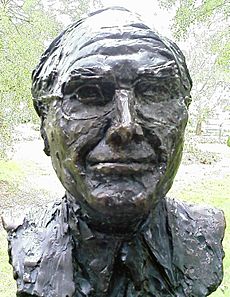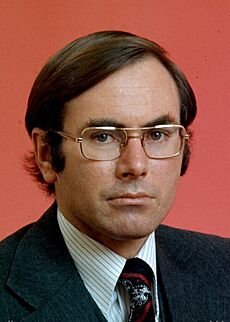John Howard facts for kids
Quick facts for kids
John Howard
|
|||||||||||||||||||||||||||||||||||||||||||
|---|---|---|---|---|---|---|---|---|---|---|---|---|---|---|---|---|---|---|---|---|---|---|---|---|---|---|---|---|---|---|---|---|---|---|---|---|---|---|---|---|---|---|---|

Howard in 2001
|
|||||||||||||||||||||||||||||||||||||||||||
| 25th Prime Minister of Australia | |||||||||||||||||||||||||||||||||||||||||||
| In office 11 March 1996 – 3 December 2007 |
|||||||||||||||||||||||||||||||||||||||||||
| Monarch | Elizabeth II | ||||||||||||||||||||||||||||||||||||||||||
| Governor-General | William Deane Peter Hollingworth Michael Jeffery |
||||||||||||||||||||||||||||||||||||||||||
| Deputy | Tim Fischer John Anderson Mark Vaile |
||||||||||||||||||||||||||||||||||||||||||
| Preceded by | Paul Keating | ||||||||||||||||||||||||||||||||||||||||||
| Succeeded by | Kevin Rudd | ||||||||||||||||||||||||||||||||||||||||||
| Leader of the Opposition | |||||||||||||||||||||||||||||||||||||||||||
| In office 30 January 1995 – 11 March 1996 |
|||||||||||||||||||||||||||||||||||||||||||
| Deputy | Peter Costello | ||||||||||||||||||||||||||||||||||||||||||
| Preceded by | Alexander Downer | ||||||||||||||||||||||||||||||||||||||||||
| Succeeded by | Kim Beazley | ||||||||||||||||||||||||||||||||||||||||||
| In office 5 September 1985 – 9 May 1989 |
|||||||||||||||||||||||||||||||||||||||||||
| Deputy | Neil Brown Andrew Peacock |
||||||||||||||||||||||||||||||||||||||||||
| Preceded by | Andrew Peacock | ||||||||||||||||||||||||||||||||||||||||||
| Succeeded by | Andrew Peacock | ||||||||||||||||||||||||||||||||||||||||||
|
|||||||||||||||||||||||||||||||||||||||||||
|
|||||||||||||||||||||||||||||||||||||||||||
| Member of the Australian Parliament for Bennelong |
|||||||||||||||||||||||||||||||||||||||||||
| In office 18 May 1974 – 24 November 2007 |
|||||||||||||||||||||||||||||||||||||||||||
| Preceded by | John Cramer | ||||||||||||||||||||||||||||||||||||||||||
| Succeeded by | Maxine McKew | ||||||||||||||||||||||||||||||||||||||||||
| Chairman of the International Democrat Union | |||||||||||||||||||||||||||||||||||||||||||
| In office 10 June 2002 – 21 November 2014 |
|||||||||||||||||||||||||||||||||||||||||||
| Preceded by | William Hague | ||||||||||||||||||||||||||||||||||||||||||
| Succeeded by | John Key | ||||||||||||||||||||||||||||||||||||||||||
| Personal details | |||||||||||||||||||||||||||||||||||||||||||
| Born |
John Winston Howard
26 July 1939 Earlwood, New South Wales, Australia |
||||||||||||||||||||||||||||||||||||||||||
| Political party | Liberal | ||||||||||||||||||||||||||||||||||||||||||
| Other political affiliations |
Coalition | ||||||||||||||||||||||||||||||||||||||||||
| Spouse |
Janette Parker
(m. 1971) |
||||||||||||||||||||||||||||||||||||||||||
| Children | 3 | ||||||||||||||||||||||||||||||||||||||||||
| Parents |
|
||||||||||||||||||||||||||||||||||||||||||
| Relatives | Bob Howard (brother) | ||||||||||||||||||||||||||||||||||||||||||
| Residences | Wollstonecraft, New South Wales | ||||||||||||||||||||||||||||||||||||||||||
| Education | Canterbury Boys' High School | ||||||||||||||||||||||||||||||||||||||||||
| Alma mater | University of Sydney (LLB) | ||||||||||||||||||||||||||||||||||||||||||
| Occupation |
|
||||||||||||||||||||||||||||||||||||||||||
| Signature | |||||||||||||||||||||||||||||||||||||||||||
John Winston Howard (born 26 July 1939) is a former Australian politician who was the 25th prime minister of Australia. He served from 1996 to 2007 as the leader of the Liberal Party of Australia. His time as prime minister lasted for nearly 12 years, making him the second-longest serving prime minister in Australia's history, after Sir Robert Menzies.
Born in Sydney, Howard became a lawyer before he entered politics. He was elected to parliament in 1974 and became the Treasurer of Australia in 1977, managing the country's economy. In 1985, he became the leader of the Liberal Party for the first time. After some years, he became leader again in 1995 and won a major victory in the 1996 election.
As prime minister, Howard's government made big changes. It brought in new gun laws after the Port Arthur massacre. It also introduced a new tax called the Goods and Services Tax (GST). His government was re-elected in 1998, 2001, and 2004.
During his time in office, Australia's military joined the wars in Afghanistan and Iraq. His government was also known for its tough policies on asylum seekers. The Australian economy grew steadily during his leadership. However, his government lost the 2007 election to the Labor Party led by Kevin Rudd. Howard also lost his own seat in parliament, which is very rare for a prime minister. After this, he retired from politics.
Contents
Early Life and Family
John Howard was the youngest of four boys. He grew up in Earlwood, a suburb of Sydney. His father and grandfather both fought in the First World War. They also owned two petrol stations where a young Howard used to work. His father passed away when Howard was 16.
As a child, Howard had a hearing problem, which made speaking a little difficult for him. He still wears a hearing aid today. He said this challenge helped him develop a very good memory.
He went to Canterbury Boys' High School, where he enjoyed debating, cricket, and rugby union. Cricket has remained a passion for him throughout his life. After high school, he studied law at the University of Sydney. He worked as a lawyer before starting his political career.
In 1971, Howard married Janette Parker, who was also a member of the Liberal Party. They have three children: Melanie, Tim, and Richard.
Start in Politics
Howard joined the Liberal Party in 1957. He was very active and became the national president of the Young Liberals, the party's group for young people.
In 1974, he was elected to the Australian Parliament, representing the electorate of Bennelong in Sydney. When the Liberal Party won the election in 1975, the new Prime Minister, Malcolm Fraser, made Howard a minister.
Treasurer of Australia
In 1977, at age 38, Howard became the Treasurer of Australia. The Treasurer is the person in charge of the country's economy and finances. He was one of the youngest Treasurers in Australian history.
During his time as Treasurer, Howard became a strong believer in free-market economics. This means he wanted less government control over businesses. He supported ideas like lower taxes and giving businesses more freedom.
The Fraser government, with Howard as Treasurer, lost the 1983 election to the Labor Party, led by Bob Hawke.
Leader of the Opposition
After the 1983 election loss, Howard became the deputy leader of the Liberal Party. In 1985, he was elected as the party's leader, which also made him the Leader of the Opposition. This meant he was the main opponent of Prime Minister Bob Hawke.
Howard led his party, the Liberal-National Coalition, into the 1987 election. However, they lost to Hawke's Labor government. In 1989, Howard lost the leadership of the Liberal Party to his rival, Andrew Peacock.
For a few years, Howard was not the leader. But in 1995, he was chosen as leader again. By this time, the Labor government had been in power for a long time, and many voters were ready for a change. Howard promised to focus on the economy and presented himself as a safe choice.
Prime Minister of Australia
In the 1996 election, John Howard led the Coalition to a huge victory. They won by a large margin, ending 13 years of Labor government. At age 56, Howard became Australia's prime minister.
First Term (1996–1998)
One of the first major events of Howard's time as prime minister was the Port Arthur massacre in 1996. In response, his government introduced strict new gun control laws across Australia. This was a difficult change to make but was seen as a major achievement.
His government also worked to introduce a Goods and Services Tax (GST). This was a tax on most things people buy. The Coalition won the 1998 election, which was seen by many as a public vote on the GST. The tax was introduced in 2000.
Second Term (1998–2001)
In 1999, Howard's government sent Australian peacekeepers to East Timor. The people of East Timor had voted to become independent from Indonesia, which led to violence. The Australian-led force helped to restore peace.
In 2001, Howard's government faced a difficult situation known as the Tampa affair. A Norwegian ship rescued hundreds of asylum seekers from a sinking boat, but the government refused to let the ship enter Australian waters. This "border protection" policy was popular with many voters.
Just a few weeks later, the September 11 attacks happened in the United States. Howard was in Washington, D.C., at the time. These events heavily influenced the 2001 election, which Howard's government won with a larger majority.
Third Term (2001–2004)

After the September 11 attacks, Howard committed Australian troops to the war in Afghanistan. He built a strong relationship with U.S. President George W. Bush.
In 2003, Australia joined the United States and other allies in the invasion of Iraq. This decision was very controversial, and large protests took place in Australian cities.
Despite the controversy over the Iraq War, the Coalition won the 2004 election. This victory gave them control of both houses of parliament: the House of Representatives and the Senate.
Fourth Term (2004–2007)

With control of the Senate, the Howard government passed major changes to workplace laws, known as WorkChoices. These laws were designed to make the hiring and firing of workers more flexible. However, they were very unpopular with trade unions and many employees.
During Howard's time as prime minister, Australia's economy was strong. The government paid off all of its debt, and unemployment fell to a low level.
By 2007, the Labor Party had a new leader, Kevin Rudd. Polls showed that Labor was much more popular than the Coalition. In the 2007 election, the Howard government was defeated. In a surprising result, Howard also lost his own seat of Bennelong to Labor's Maxine McKew. He was only the second prime minister in Australian history to lose his seat while in office.
Life After Politics
After leaving politics, John Howard has remained active. He gives speeches around the world and often comments on political issues. He has also written a book about his life, called Lazarus Rising.
In 2008, he was appointed a Companion of the Order of Australia, one of the country's highest honours. In 2012, Queen Elizabeth II appointed him to the Order of Merit, a special honour given to individuals of great achievement.
Howard has also been involved with organisations like the International Democrat Union and the Bradman Foundation, which honours the famous cricketer Sir Donald Bradman.
Honours

Over the years, John Howard has received many awards and honours for his service.
- 2008: Companion of the Order of Australia (AC)
- 2009: Presidential Medal of Freedom, awarded by the President of the United States.
- 2012: Member of the Order of Merit (OM), awarded by Queen Elizabeth II.
- 2013: Grand Cordon of the Order of the Rising Sun, from the government of Japan.
He has also received honorary degrees from several universities in Australia and around the world.
Images for kids
-
Howard and US Secretary of Defense William Cohen in 1997
-
Election balloons for the Liberal and Labor parties in Bennelong during the 2007 federal election
-
Howard (left) being awarded the Presidential Medal of Freedom by U.S. President George W. Bush
See also
 In Spanish: John Howard para niños
In Spanish: John Howard para niños
- First Howard Ministry
- Second Howard Ministry
- Third Howard Ministry
- Fourth Howard Ministry
- SIEV X









